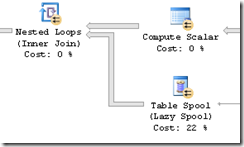http://www.scarydba.com/2011/06/15/rebind-and-rewind-in-execution-plans/
Ever looked at an execution plan? If you answered no, you can’t possibly have ever tried to tune a query, or, you’re doing it wrong. For every one else, no doubt you’ve looked at the tool tips or the property sheets of an operator and you’ve seen the Rebind & Rewind properties and wondered what the heck they mean. Me too.
I learned as much as I could for the book on execution plans and I spent two pages describing it. Then, a little while ago, on the SQL Cruise, someone asked me to describe them and I was flummoxed. Specifically they said the explanation in the book was insufficiently clear, so I promised to put together a blog post on the topic, both to attempt to clarify my explanation and to reacquaint myself with the topic.
These properties reflect the number of times an operator was initialized, or started. It’s that easy for the initial definition. But it gets complicated quickly. Rebind & Rewind are only applicable when dealing with a loop join. They don’t apply to other situations, which is why they’re mostly zero when you see them. They are only applicable to the inner side of the loop.
Not only are Rebind and Rewind only involved with loop joins, but they only apply to certain operators: Nonclustered Index Spool, Remote Query, Row Count Spool, Sort, Table Spool, and Table-valued Function.
The difference between a rebind and rewind has to do with the values that are part of the loop join itself. As those values change, as different data is accessed in the outer part of the loop, you see rebinds. When those values aren’t changed then you’ll see a rewind. You’ll also see that the aggregation of these values is equal to the number of rows in the outer join.
Here’s an example query:
[sourcecode language=”sql”]SELECT sod.SalesOrderDetailID FROM Sales.SalesOrderDetail AS sod WHERE LineTotal < (SELECT AVG(dos.LineTotal) FROM Sales.SalesOrderDetail AS dos WHERE dos.ModifiedDate < sod.ModifiedDate )[/sourcecode] It puts out an execution plan that’s pretty ugly, but at least it shoes a table spool in a loop join as you can see: 
If you look at the properties then we can see the values showing multiple rebinds and rewinds that total up to the number of rows in the outer part of the loop.
